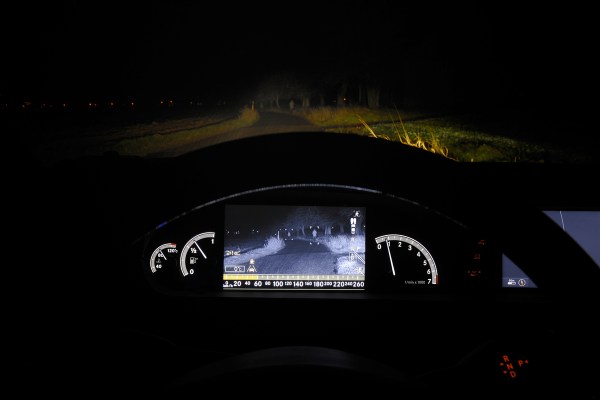Technology market analysts at ABI Research predict that advanced driver assistance systems (ADAS) are going to be big business in the next decade — to the tune of $132 billion. But they also predict the decline and fall of night vision in our cars.
Night vision systems have been available for vehicles since the early 2000s. They use either infrared or thermographic cameras to scan the dark road ahead for people or animals and alert the driver to the problem. ABI Research calls this vulnerable user detection, or VUD. Some systems show the outline of the pedestrian in the center console screen or a heads-up display, or the system might just show a warning in the dashboard to tell the driver there’s something out there to watch for.
The 2016 Mercedes-Benz S-Class, for instance, has Night Vision Assist Plus, which uses both thermal and infrared imaging to display in the instrument cluster a real-time view of the road. It also scans for pedestrians and animals along the side of the road (whitetail deer, I’m looking at you — thermographically) and will flash the headlights to let pedestrians know there’s a car coming.
This seems pretty cool, but ABI Research notes that it’s not as cool — or as useful and forward-thinking — as the ADAS tech that’s becoming more available. The idea behind things like automatic emergency braking (AEB) and the related VUD systems is that the car’s cameras and sensors will take in this information and act on it before the driver even realizes there’s a problem. Rather than taking the time to show you the outline of a pedestrian and wait for you to brake, the car will just do it. AEB will be in all new cars starting in 2022, and companies like Honda and Toyota are rolling it out widely, even in inexpensive models.
Analyst James Hodgson said in an ABI Research statement, “Within the next decade, the focus will migrate away from augmenting driver perception and toward sensors that can enable autonomous control for both navigation and emergency collision avoidance. Therefore, there will be a limited need for car OEMs to provide a system that allows the human driver or car occupant to see in the dark.”
Given that Ford’s autonomous test car just navigated desert roads in the dark and without a human at the wheel, Hodgson makes a good point. Technology is going to move away from getting the driver’s attention and toward taking over quickly and, we hope, correctly.
